- Tutorials
- Kicks ( 차기 chagi )
- 540º Whirl Kick ( 540º도 돌개차기 540º dolgae-chagi )
Taekwondo 태권도Taekwondo Preschool
Promotion from one geup to the next can proceed rapidly in some schools, since schools often allow geup promotions every two, three, or four months. Students of geup rank learn the most basic techniques first, and then move on to more advanced techniques as they approach first dan. Many of the older and more traditional schools often take longer to allow students to test for higher ranks than newer, more contemporary schools, as they may not have the required testing intervals. View Taekwondo belt levels »

540º Whirl Kick
540º도 돌개차기 540º dolgae-chagi
A kick (차기 chagi) is a physical strike using the foot, leg, or knee. The striker relaxes to the extent possible during the strike, tensing the muscles of much of the body only at the time of impact, then relaxing again to recoil the striking part. Relaxation enables the strike to achieve the greatest possible velocity during travel, while rigidity at impact allows the maximum transfer of force.
Difficulty Level: Advanced Technique: Kick ( 차기 chagi )
In martial arts and tricking, the 540º Whirl Kick ( 540도 돌개차기 540º dolgae-chagi ), also known as inside turning kick, jump inside kick, and tornado kick, is a Jump Kick ( 뛰어차기 ttwieo-chagi ) move. It involves a rotation of approximately 540º (although usually, when performed correctly, the performer has really only done a spin of 360º not including whatever takeoff they used).
It is practiced through various disciplines including Taekwondo, but traditionally most associated with the Korean martial arts taekwondo. However, the most prominent defining feature is that the same leg is used for taking off, kicking, and landing. The other leg mainly helps get the performer into the air, and then the leg is pulled back before the landing. Many martial arts tricksters choose this move as their first move to attempt.
Remember to thoroughly do some warm-up and basic stretching activities before lifting your legs too high. Stretching should only be started when muscles are warm and the body temperature is raised. If done improperly, one can pull their hamstrings ( 햄스트링 haemseuteuling ) which is defined as an excessive stretch or tear of muscle fibers and related tissues. Hamstring injuries are common in athletes participating in taekwondo and are very difficult to treat and rehabilitate.
Effective accomplishment of the 540º Whirl Kick ( 540도 돌개차기 540º dolgae-chagi ) relies on mental preparation combined with an athletic condition. For instance, a typical element of the preparation consists in mentally exercising and visualizing the kick ( 차기 chagi ) before its execution. The 540º Whirl Kick ( 540도 돌개차기 540º dolgae-chagi ) correctly performed requires to land on both feet while keeping balance when finishing the kicking technique.
The high-level advanced kick ( 차기 chagi ) is most commonly performed for board breaking ( 격파 gyeokpa ) demonstrations and rarely seen during sparring ( 겨루기 gyeorugi ).
Taekwondo practitioners may include a shout or yell ( 기합 kihap ), to help tense the muscles at impact and distract or frighten the opponent. Practitioners generally exhale as the kick ( 차기 chagi ) nears the target. Breath control is also important to relax the body when not attacking; novice practitioners often waste significant energy because they are tense at inappropriate times.
Training Methods
How well one improves with training depends on several factors, such as the frequency it is engaged in, and the type of feedback that is available for improvement. If a student does not train often enough, reinforcement fades, and he or she is likely to forget what was learned.
The kick ( 차기 chagi ) is best learned initially striking at the air as though there is an opponent but focusing on the form, speed, control, and technique; then moving on to soft surfaces striking punch mitts and target pads. Large heavy bags are used more for strength and endurance, while smaller targets such as punch mitts and target pads focus on faster kicking speed, timing and coordination. Target pads are useful for training mobility and accuracy on a moving target.
Difficulty of Technique
Taekwondo students of geup ranking learn the most basic techniques first, and then move on to more advanced and difficult techniques as they approach 1st Dan Black Belt. The more difficult the technique, the more practice may be needed for the purpose of improving or mastering it, as in the phrase 'practice makes perfect'. Every technique must display the requisite speed, balance, power and firmness to be realistically used as an attack or defense move.
* Please see a certified Master Instructor ( 사범님 sabeomnim ) for training. Proper guidance and instructions are needed to ensure safe training.
Promotion Tests
Students often undergo periodic testing and grading by their own Master Instructor ( 사범님 sabeomnim ) in order to advance to a higher level of recognized achievement such as a different belt color. They need to demonstrate their proficiency in the various aspects of the art such as the execution of patterns ( 품새 poomse ), which combine various techniques in specific sequences.
540º Whirl Kick ( 540º도 돌개차기 540º dolgae-chagi ) is a requirement for the below belt levels (Techniques vary between schools). Promotion from one belt level to the next can proceed rapidly in some schools, since schools often allow geup promotions every two, three, or four months. Students of geup rank learn the most basic techniques first, and then move on to more advanced techniques as they approach first dan black belt. View Promotion Tests »
Advertisement
540º Whirl Kick ( 540도 돌개차기 540º dolgae-chagi )
Variations
Like most variations of martial arts kicks, the name of the kick is normally determined by the position of the foot, degree of rotation and positioning of the hips, and any additional kicks that may be added.
Fake 540º
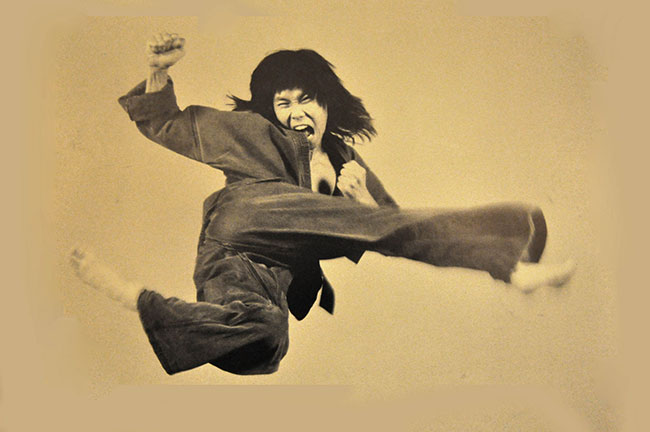
A jump kick that mimics the 540º. You throw it up into an inside crescent, tuck the other and land on that right foot. The left doesn't take off like a true 540º.
540º Crescent
This is the most traditional variation of the kick. The kick is executed as a crescent kick, meaning that the toes are pointed directly up. If aiming for a target, the target would be hit with the inside of the foot (from the heel to the big toe).
Reverse 540º
Take off is like a 1-over 360º kick. If back on your right foot, throw it forward counterclockwise, tuck it and push off with your right. Jump up and complete 360º with an outside, counterclockwise crescent kick and land on the same foot. Look at the reverse image of a 540º and you can see it.
540º Roundhouse
This version is rotates the hips about 90° more than a crescent before executing the kick. The kick is executed as a roundhouse kick, meaning the foot is flat and the toes are pointing straight forward. If aiming for a target, the target would be hit with the top of the ankle to avoid breaking the toes. In taekwondo a generic 540º kick usually refers to the 540 roundhouse.
Lazyboy 540º (aka Playboy 540º)
Also referred to as simply a Lazyboy, this version is practically identical to a typical 540º. The defining characteristic is that the hands are placed on the back of the head. Sometimes they're placed on top of the head. This is to simulate the image of a person relaxing or lying down. This pose is struck in the air as the trick is performed to show the ease in which they can perform the trick, that they don't need the momentum of the arms to complete the trick, and/or to add style to the trick. This trick is also known as the Playboy 540º for its extravagance and confident posture such of a playboy.
Double leg 540º
Take off on two legs with inside crescent kick.
Sideswipe
Though, the body mechanics/execution are different, the Sideswipe and 540º are often categorized together because they both use the same leg to take off, kick, and land. This version is similar to a 540º kick, but the body is spinning as close to horizontal as possible. After the non-kicking leg is thrown up in the take-off, the body is leaned back so it is spinning horizontally. This move is not very useful as a fighting move, because it is hard to direct the kick to actually hit someone, and if the foot actually hits the target, all rotation will stop and the performer will be left without a leg to land on. Some may say this is the same case for the normal 540º, but in the sideswipe, the body will be horizontal and it will be much more difficult to quickly direct the other foot to the ground to land on. And is a trick for a Combo kick.
540º Wheel
Also called a "540º hook", "Cheat 720º", and "540º crescent" (which can make it confusing to distinguish between this kick and the one above). It uses the same takeoff, but instead of using the jumping leg to kick, the performer spins around another 90-180 degrees and performs a kick with the other leg. This kick can be either a hook or a crescent kick depending on the position of the foot. This kick is one of the few variations that actually spins a full 540º.
540º Gyro
In this move, the user will execute the typical 540º kick but instead of landing immediately on the kicking leg, he/she will rotate an additional 180–360 degrees before landing. It is rather uncommon in the tricking community, but is present in martial arts disciplines. It is most prevalent in Wushu.
540º to Splits
The traditional 540º however can be landed into the splits simply by sending the kicking leg backwards after the kick as been executed and extending the other leg forward during the landing. Theoretically, almost every trick can be landed in the splits, however, landing some of the more advanced versions of tricks like this would require extra height in the jump, extra rotation of the body, and a very keen sense of timing and spatial awareness.
Multi-kick variants
Some variants of the 540º include multiple kicks being executed while in the air. Some of those variations are:
Crescent 540º/Feilong
Not to be confused with the 540º crescent, a crescent 540º is were a crescent kick is thrown out with one leg before the 540 kick is thrown with the other, essentially executing two separate kicks during the same motion. A slight variation of this is were the crescent kick is thrown as a sideways snap kick, followed by a round house kick. The hips must be rotated more before the kicks are thrown and the body tilts in the direction of the kicks, which can cause a person to lose their balance on the landing.
Jack-knife
This is similar to a crescent 540º in that each leg does its own kick, however, the 540º kick (either crescent or roundhouse) is thrown out first. Immediately following the first kick, the other leg throws a heel kick. Ideally, both kicks should be executed before the first 540º kick lands. The mechanics to this variant are practically identical to a 540º wheel or cheat 720º. A helpful tip to proper execution involves performing a roundhouse kick instead of an inside crescent kick, with the hips turned over and toes pointed. In doing so, after the first kick is completed, your hips are already turned over, and your body is in a better position to spin around and snap out the hook.
540º Triple
This is the combination of a crescent 540º and a jack-knife, essentially executing three separate kicks during the same motion. One with the landing leg and two with the other. The kicks and their execution are similar to those of a 720º triple.

Did you know?
Taekwondo Olympic Demonstration Sport

Taekwondo made its first appearance at the Summer Olympic Games as a demonstration sport at the 1988 Summer Olympics in Seoul, South Korea. The opening ceremony featured a mass demonstration of taekwondo with hundreds of adults and children performing moves in unison. Taekwondo was again a demonstration sport at the 1992 Summer Olympics in Barcelona, Spain. For more information View Taekwondo Olympic Demonstration Sport »
| Year | Date | Flag | City | Host Country |
| 1992 | July 25 - August 9 |  |
Barcelona | Spain |
| 1988 | September 17 - Oct 2 |  |
Seoul | South Korea |
RESOURCES
This article uses material from the Wikipedia article "Taekwondo at the Summer Olympics" which is released under the Creative Commons Attribution-Share-Alike License 3.0.
Advertisement
540º Whirl Kick ( 540도 돌개차기 540º dolgae-chagi )
Striking Surface
Various surfaces of the foot may be engaged as the striking surface depending on which area of the opponents body which is being targeted. This leads to a large array of kicks. For more information on Impact Surface Areas »
( Click image for additional information)
Suitable Targets
Experienced strikers learn through repetition and muscle memory when (not just how) to launch particular strikes, based on the circumstances they are facing. Focus helps in achieving proper penetration and in maximizing the damage at the point of impact to the area of the opponents body which is being targeted. For more information on Impact Surface Areas »
( Click image for additional information)
Technique Injuries
Collisions with the ground, objects, and other taekwondo practitioners are common, and unexpected dynamic forces on limbs and joints can cause injury. Taekwondo injuries can also occur in techniques if done improperly or from overuse of a particular body part. Taking a break from training or reducing the volume and the intensity of the training will allow the body to recover. For more information on Injuries »
( Click image for additional information)
Some Stance(s) ( 서기 sogi ) used with this Kick ( 차기 chagi )
An example of the union of mental and physical discipline is the combination of stance ( 서기 sogi ), footwork ( 딛기 ditgi ), and technique (either with kick, block and/or strike), which requires both physical mastery of the technique and the concentration to focus one's power. Experienced practitioners learn through repetition and muscle memory when (not just how) to launch particular techniques, based on the circumstances they are facing.
( Click image for additional information)
540º Whirl Kick ( 540도 돌개차기 540º dolgae-chagi )
Use in Sparring ( 겨루기 gyeorugi )
Under World Taekwondo (WT) and Olympic rules, sparring is a full-contact event and takes place between two competitors in an area measuring 8 meters square. A win can occur by points, or if one competitor is unable to continue (knockout) the other competitor wins. Points are awarded for permitted, accurate, and powerful techniques to the legal scoring areas; light contact does not score any points. For more information on World Taekwondo (WT) Tournament Sparring » 
( Click image for additional information)
Use in Self-Defense ( 호신술 hosinsool ) Applications
Self-Defense is to protect yourself from being attacked from would-be aggressors. It is a countermeasure that involves defending the health and well-being of oneself from harm and is designed primarily to cause injury or quickly incapacitate an attacker, in addition to being a deterrent against them. Attackers are typically larger, stronger, and are often armed or have an accomplice. With proper execution attackers may be incapacitated with a single blow, which lessens the number of attacks with multiple people. For more information on Self-Defense ( 호신술 hosinsool ) »
Each technique must be correctly timed and aligned in order to defend effectively. Taekwondo practitioners must have their body weight correctly distributed during the stance ( 서기 sogi ) including proper footwork ( 딛기 ditgi ). The kick ( 차기 chagi ) is not performed during Self-Defense ( 호신술 hosinsool ) scenarios.
( Click image for additional information)
Use in One-Step Sparring
One-Step Sparring is performed with a partner in which predefined movements are practiced. One student is the attacker while the other student responds with defenses, counterattacks, and/or other actions, based on part of the predefined movements. For more information on One-Step Sparring »
The kick ( 차기 chagi ) is not featured during One-Step Sparring practice. Fundamentally, taekwondo One-Step Sparring is one of the learning grounds for real combat. As such, every technique including stance ( 서기 sogi ) must display the requisite speed, power and firmness to be realistically used as an attack or defense move. One-Step Sparring varies between schools.
( Click image for additional information)
Use in Breaking ( 격파 gyeokpa )
The discipline of destroying inanimate objects such as wooden boards, baseball bats, ice blocks or cement bricks and is a feature common to martial arts including taekwondo. A single board or stack of boards may be broken or, alternatively, a series of boards may be broken in a pre-set sequence utilizing a variety of strikes. Advanced competitors may even break several boards in a single jump with multiple kicks before landing. For more information on Breaking ( 격파 gyeokpa ) »
( Click image for additional information)

Did you know? Taekwondo Preschool Master Edition Available Now
Taekwondo Preschool Master Edition


The book Taekwondo Preschool Master Edition provides in-depth information on the explosive and powerful techniques of taekwondo. There are lots of illustrations and interactive content within the master edition guidebook with over 1500+ pages. Are you prepared to learn the Korean Martial Arts! The book is available for download with Apple Books on your Mac or iOS device, and with iTunes on your computer. Books can be read with Apple Books on your Mac or iOS device.
View more information about the book »
- Taekwondo Stances ( 서기 sogi )
- Taekwondo Blocking ( 막기 makgi )
- Taekwondo Kicking ( 차기 chagi )
- Taekwondo Fist Strikes ( 지르기 jireugi )
- Taekwondo Strikes ( 치기 chigi )
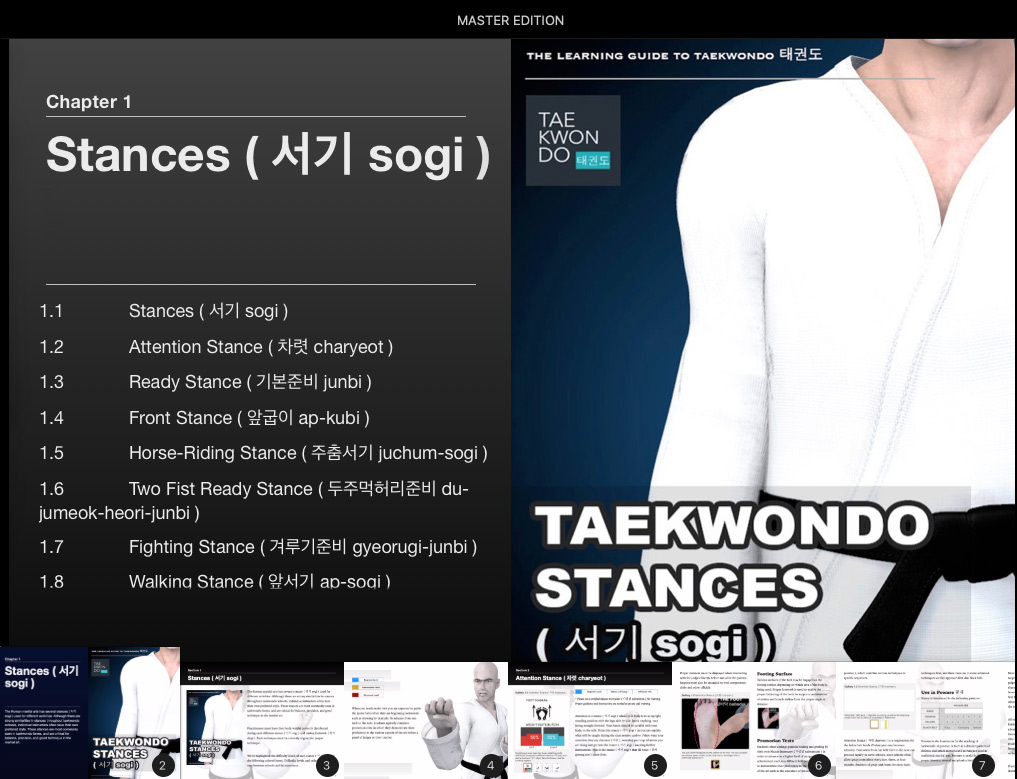
Taekwondo Preschool Master Edition

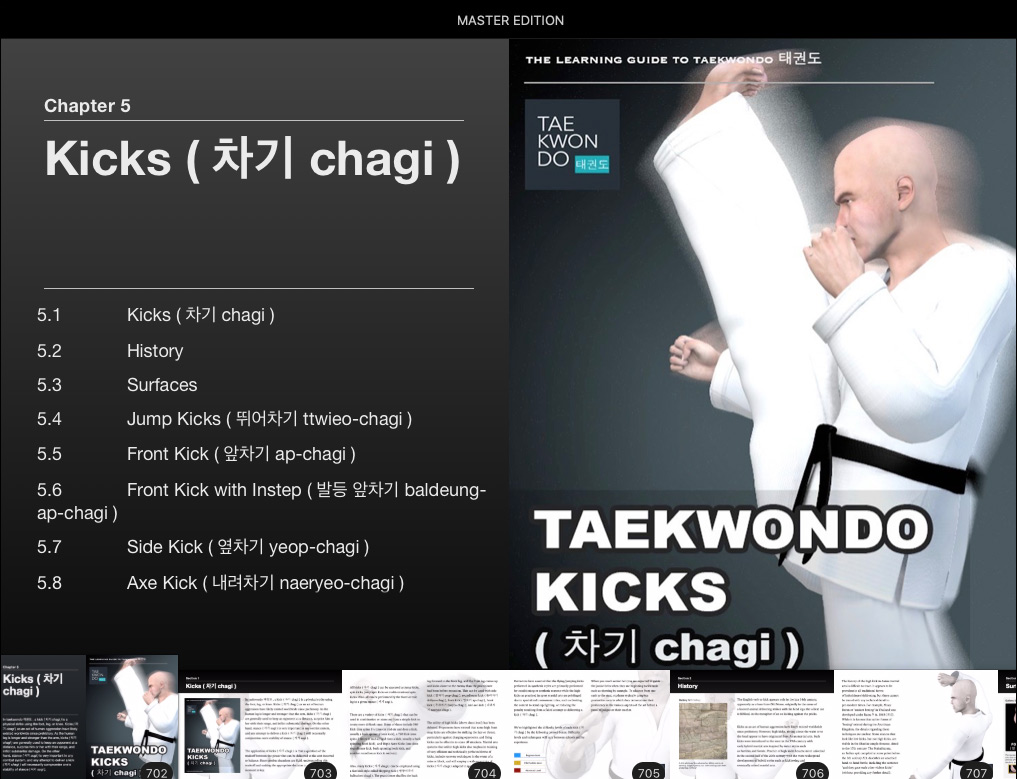
Taekwondo Preschool Master Edition

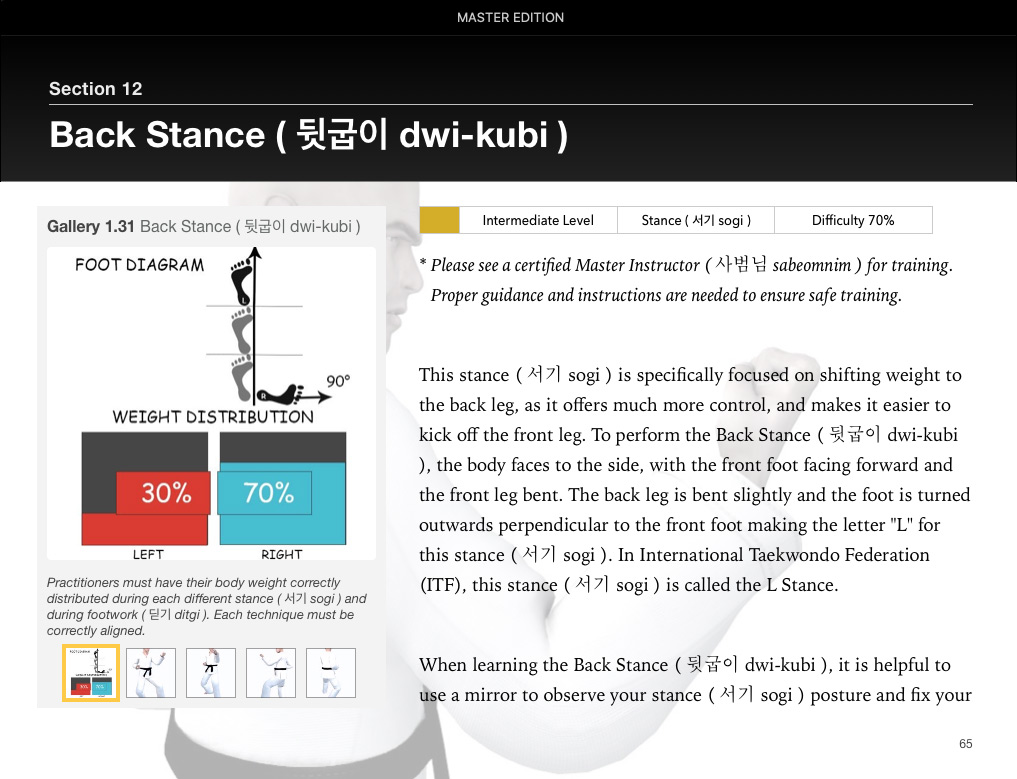
Taekwondo Preschool Master Edition
Sample: The Back Stance ( 뒷굽이 dwi-kubi ) is specifically focused on shifting weight to the back leg, as it offers much more control, and makes it easier to kick off the front leg


Taekwondo Preschool Master Edition
Sample: The Keumgang Punch ( 금강지르기 keumgang-jireugi ) is an advanced technique that requires you to punch ( 지르기 jireugi ) and block upwards ( 올려막기 olgul makgi ) at the same time

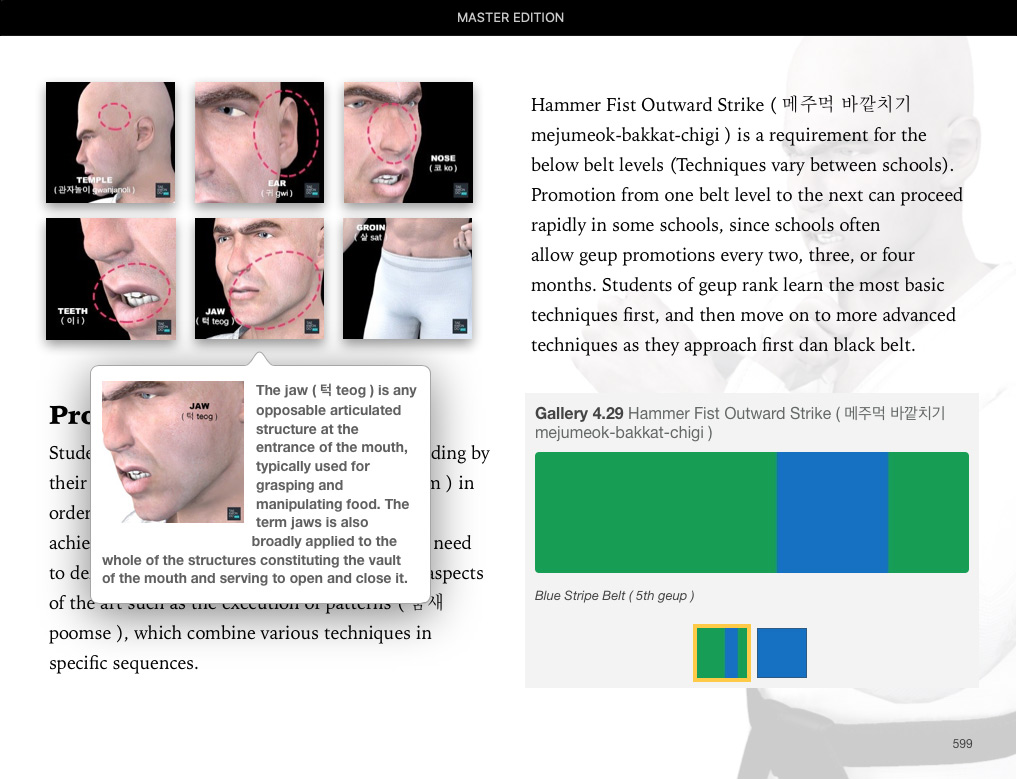
Taekwondo Preschool Master Edition
Sample: Hammer Fist Outward Strike ( 메주먹 바깥치기 mejumeok-bakkat-chigi ) is an intermediate strike that is delivered by hitting the opponent's chest to the upper area of the face with the closed fist sideways at full velocity

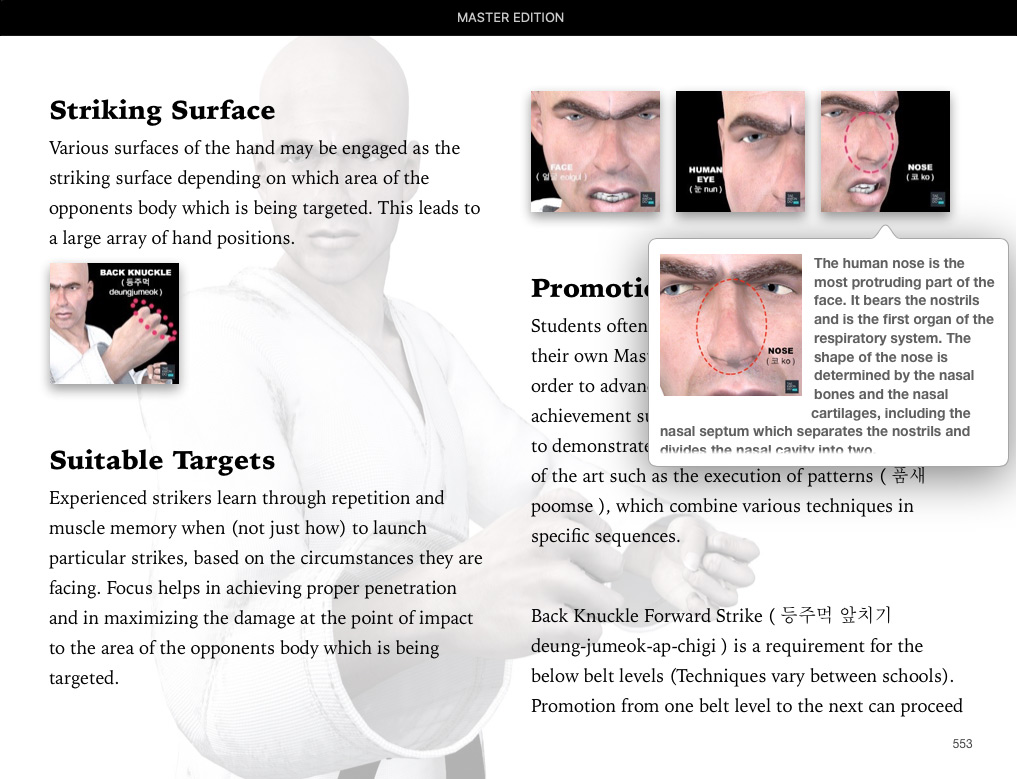
Taekwondo Preschool Master Edition
Sample: Back Knuckle Forward Strike ( 등주먹 앞치기 deung-jumeok-ap-chigi ) should pass over from the opposite waist to the armpit, to the chin level and then hitting with the back of the fist to the opponent's face

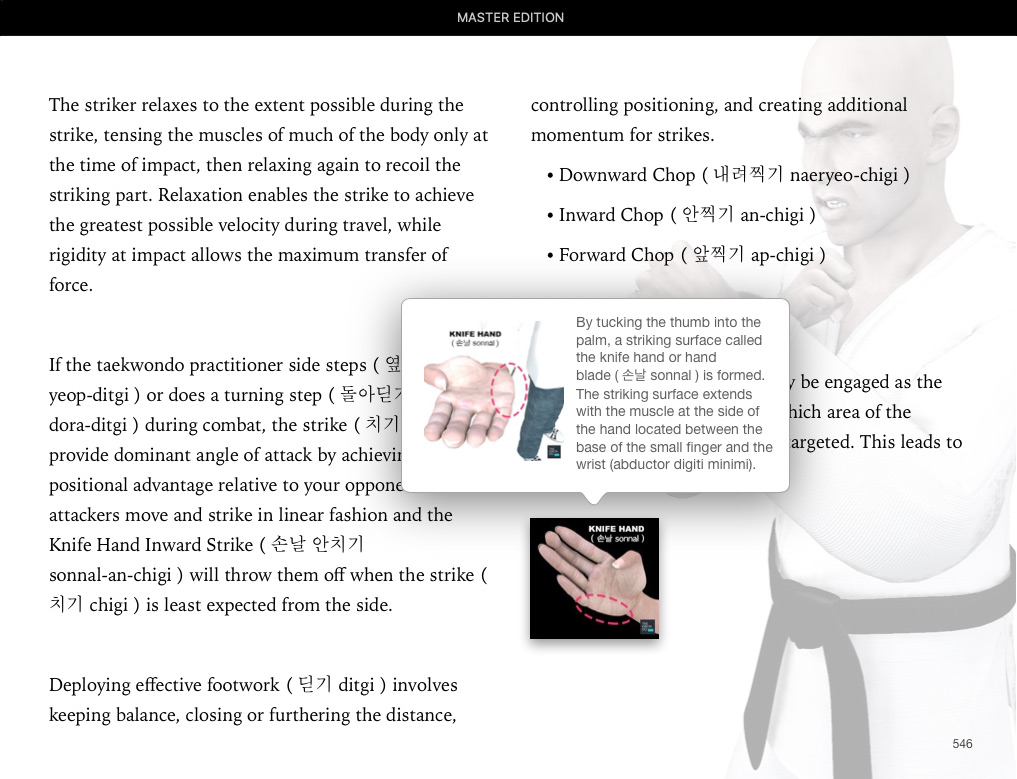
Taekwondo Preschool Master Edition
Sample: Knife Hand Inward Strike ( 손날 안치기 sonnal-an-chigi ) is an intermediate technique that is executed by striking with the muscle at the side of the hand located between the base of the small finger and the wrist

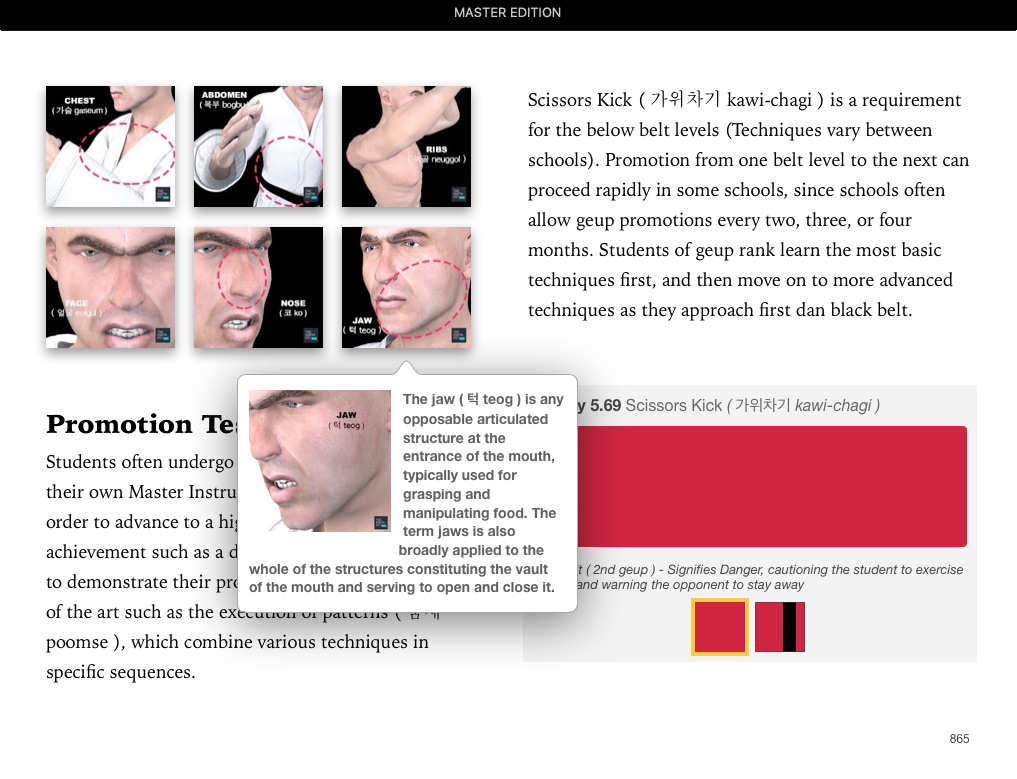
Taekwondo Preschool Master Edition
Sample: The Scissors Kick ( 가위차기 kawi-chagi ) is delivered while in the air moving forward into two opponents simultaneously after a running start to gain forward momentum

( Click image for additional information)
540º Whirl Kick ( 540도 돌개차기 540º dolgae-chagi )
Use in Patterns ( 품새 poomse )
Poomse is the foundation for the teaching of taekwondo. A poomse or form is a detailed pattern of defense-and-attack motions and techniques used in traditional martial arts. Poomse is useful in developing proper kinetics, mental and physical fortitude.
( Click image for additional information)
Most Kukkiwon 국기원 schools will use the poomse taegeuk whereas a few schools will use the poomse palgwe. The meanings, trigrams and symbols are shared by both poomse taegeuk and poomse palgwe, however the sequence of movements is different. The first 8 forms of the set of poomse differ from each other, whereas the last 9 forms (Black Belt forms) of the set are shared between the two sets. All students studying in World Taekwondo (WT) Kukkiwon style must learn these forms, or taegeuk, to advance to a higher belt level. There are eight taegeuk forms, each one similar to the previous one, but each time with more complicated techniques to display the students' mastery of the techniques learned during lessons, as well as the ability to interconnect these techniques.
For more information on taekwondo patterns refer to Poomse 품새 Section »
Use in Demonstrations
To promote taekwondo for its emphasis on high kicking and fast hand techniques, taekwondo schools perform at tournaments, community events, shopping malls, parks, and tv shows. Demonstrations vary from school to school, but may include such elements as the execution of poomse ( 품새 poomse ), which combine various techniques in specific sequences; the breaking of boards to demonstrate the ability to use techniques with both power and control; sparring ( 겨루기 gyeorugi ) and self-defense ( 호신술 hosinsool ) to demonstrate the practical application and control of techniques; physical fitness usually with push-ups and sit-ups. For more information on Demonstrations »
The kick ( 차기 chagi ) is commonly used in demonstration activities such as when performing board breaking ( 격파 gyeokpa ) and/or self-defense ( 호신술 hosinsool ) scenarios which are some of the foundations for the teaching of taekwondo.
( Click image for additional information)
Use in Warming-Up
A warm-up generally consists of a gradual increase in intensity in physical activity, joint mobility exercise, and stretching, followed by the activity. Warming-up brings the body to a condition at which it safely responds to nerve signals for quick and efficient action. For more information on Warming-Up »
( Click image for additional information)
Additional Resources
Taekwondo Kicks ( 차기 chagi )
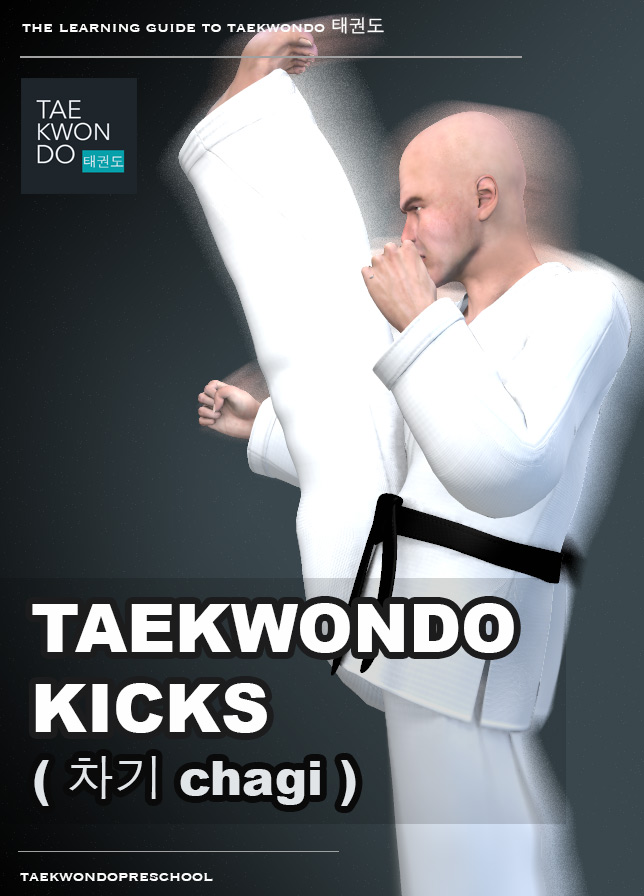
This book is available for download with Apple Books on your Mac or iOS device, and with iTunes on your computer. Book can be read with Apple Books on your Mac or iOS device.
Taekwondo is known for its emphasis on high kicking and fast hand techniques. A kick ( 차기 chagi ) is a physical strike using the foot ( 발 bal ), leg, or knee ( 무릎 mureup ). As the human leg is longer and stronger than the arm, kicks are generally used to keep an opponent at a distance, surprise him or her with their range, and inflict substantial damage. On the other hand, stance ( 서기 sogi ) is very important in any combat system, and any attempt to deliver a kick ( 차기 chagi ) will necessarily compromise one's stability of stance ( 서기 sogi ).
View more information about Book »
Taekwondo Kicks ( 차기 chagi ) |
|||||
| Hangul 한글 | Korean | Belt Requirement | Difficulty Level | Information | |
| Jump Kick | 뛰어차기 | ttwieo-chagi | Varies | Varies | Information » |
| Jumping Front Kick | 뛰어 앞차기 | ttwieo-ap-chagi |   |
Beginner Level | Information » |
| Jumping Side Kick | 뛰어 옆차기 | ttwieo-yeop-chagi |   |
Beginner Level | Information » |
| Front Kick | 앞차기 | ap-chagi |   |
Beginner Level | Information » |
| Front Kick with Instep | 발등 앞차기 | baldeung-ap-chagi |   |
Beginner Level | Information » |
| Front Kick with Ball of the Foot | 앞축 앞차기 | apchuk-ap-chagi |   |
Beginner Level | Information » |
| Side Kick | 옆차기 | yeop-chagi |   |
Beginner Level | Information » |
| Axe Kick | 내려차기 | naeryeo-chagi |   |
Beginner Level | Information » |
| Flying Kick | 두발당성차기 | dubaldangseong-chagi |  |
Beginner Level | Information » |
| Front Foot Kick | 앞발 차기 | apbal-chagi |  |
Beginner Level | Information » |
| Front Foot Front Kick | 앞발 앞차기 | apbal-ap-chagi |  |
Beginner Level | Information » |
| Front Foot Side Kick | 앞발 옆차기 | apbal-yeop-chagi |  |
Beginner Level | Information » |
| Front Foot Axe Kick | 앞발 내려차기 | apbal-naeryeo-chagi |  |
Beginner Level | Information » |
| Roundhouse | 돌려차기 | dollyeo-chagi |    |
Beginner Level | Information » |
| Instep Turn Kick | 발등 돌려차기 | baldeung-dollyeo-chagi |    |
Beginner Level | Information » |
| Back Kick | 뒤차기 | dwi-chagi |    |
Intermediate Level | Information » |
| Reverse Side Kick | 반대 옆 차기 | bandae-yeop-chagi |    |
Intermediate Level | Information » |
| Inward Crescent Kick | 안차기 | an-chagi |   |
Intermediate Level | Information » |
| Outward Crescent Kick | 바깥차기 | bakkat-chagi |   |
Intermediate Level | Information » |
| Whirl Kick 360º | 360도 돌개차기 | 360º dolgae-chagi |  |
Intermediate Level | Information » |
| Front Foot Roundhouse | 앞발 돌려차기 | apbal-dollyeo-chagi |  |
Intermediate Level | Information » |
| Hook Kick | 후려차기 | huryeo-chagi |   |
Intermediate Level | Information » |
| Counter Kick | 받아차기 | bada-chagi |   |
Intermediate Level | Information » |
| Rear Foot Counter Kick | 뒷발 받아차기 | dwitbal-bada-chagi |   |
Intermediate Level | Information » |
| Front Foot Counter Kick | 앞발 받아차기 | apbal-bada-chagi |   |
Intermediate Level | Information » |
| Skipping Kick | 발붙여차기 | balbucheo-chagi |  |
Intermediate Level | Information » |
| Skipping Front Kick | 발붙여 앞차기 | balbucheo-ap-chagi |  |
Intermediate Level | Information » |
| Skipping Side Kick | 발붙여 옆차기 | balbucheo-yeop-chagi |  |
Intermediate Level | Information » |
| Skipping Roundhouse Kick | 발붙여 돌려차기 | balbucheo-dollyeo-chagi |  |
Intermediate Level | Information » |
| Skipping Axe Kick | 발붙여 내려차기 | balbucheo-naeryeo-chagi |  |
Intermediate Level | Information » |
| Jumping Axe Kick | 뛰어 내려차기 | ttwieo-naeryeo-chagi |   |
Intermediate Level | Information » |
| Jumping Turn Kick | 뛰어 돌려차기 | ttwieo-dollyeo-chagi |   |
Intermediate Level | Information » |
| Jumping Inward Crescent Kick | 뛰어 안차기 | ttwieo-an-chagi |   |
Intermediate Level | Information » |
| Jumping Outward Crescent Kick | 뛰어 바깥차기 | ttwieo-bakkat-chagi |   |
Intermediate Level | Information » |
| Pushing Kick | 밀어차기 | mireo-chagi |   |
Intermediate Level | Information » |
| Pushing Front Kick | 밀어 앞차기 | mireo-ap-chagi |   |
Intermediate Level | Information » |
| Pushing Side Kick | 밀어 옆차기 | mireo-yeop-chagi |   |
Intermediate Level | Information » |
| Jumping Back (Thrust) Kick | 뛰어 뒤차기 | ttwieo-dwi-chagi |   |
Intermediate Level | Information » |
| Alternating Kick | 이어차기 | ieo-chagi |   |
Intermediate Level | Information » |
| Knee Upward Strike | 무릎 올려치기 | mureup-ollyeo-chigi |  |
Intermediate Level | Information » |
| Target Kick | 표적차기 | pyojeok-chagi |   |
Advanced Level | Information » |
| Front Foot Whip Kick | 앞발 후려차기 | apbal-huryeo-chagi |   |
Advanced Level | Information » |
| Spin Hook Kick / Back Roundhouse Kick | 뒤후려차기 | dwi huryeo chagi |     |
Advanced Level | Information » |
| Scissors Kick | 가위차기 | kawi-chagi |   |
Advanced Level | Information » |
| Twisting Kick | 비틀어차기 | biteureo-chagi |   |
Advanced Level | Information » |
| Jumping Back Whip Kick | 뛰어 뒤후려차기 | ttwieo-dwi-huryeo-chagi |   |
Advanced Level | Information » |
| Skipping Whip Kick | 발붙여 후려차기 | balbucheo-huryeo-chagi |   |
Advanced Level | Information » |
| Repeating Kick | 거듭 차기 | geodeup-chagi |   |
Advanced Level | Information » |
| Repeating Side Kick | 거듭 옆차기 | geodeup-yeop-chagi |   |
Advanced Level | Information » |
| Repeating Turn Kick | 거듭 돌려차기 | geodeup-dollyeo-chagi |   |
Advanced Level | Information » |
| Front Kick with Heel of Foot | 뒤축 앞차기 | dwichuk-ap-chagi |   |
Advanced Level | Information » |
| Turn Kick with Ball of Foot | 앞축 돌려차기 | apchuk-dollyeo-chagi |   |
Advanced Level | Information » |
| 360º Back Whip Kick | 360도 뒤후려차기 | 360º dwi-huryeo-chagi |  |
Advanced Level | |
| 540º Back Whip Kick | 540도 뒤후려차기 | 540º dwi-huryeo-chagi |  |
Advanced Level | |
| Whirl Kick 540º | 540도 돌개차기 | 540º dolgae-chagi |  |
Advanced Level | Information » |
| Whirl Kick 720º | 720도 돌개차기 | 720º dolgae-chagi |  |
Advanced Level | Information » |
| Whirl Kick 1080º | 1080도 돌개차기 | 1080º dolgae-chagi |  |
Advanced Level | Information » |
| Jumping Flip Kick | 공중제비차기 | gongjungjebi-chagi |  |
Advanced Level | Information » |
| Multi-Direction Kick | 다방향차기 | dabangyang-chagi |  |
Advanced Level | Information » |
| Single Line-up Break | 일렬격파 | illyeol-gyeokpa |  |
Advanced Level | Information » |
| Holding Kick | 잡고차기 | japgo-chagi |  |
Advanced Level | Information » |
| Holding Whip Kick | 잡고 후려차기 | japgo-huryeo-chagi |  |
Advanced Level | |
| Jump Two-Foot Front Kick | 뛰어 두발 앞차기 | ttwieo-dubal-ap-chagi |  |
Advanced Level | Information » |
Advertisement

Quiz
Question. In what year was Kukkiwon ( 국기원 ) being officially named on?
Kukkiwon ( 국기원 ), also known as World Taekwondo Headquarters, and home of the World Taekwondo Academy, is the official taekwondo governing organization established by the South Korean government. It is supervised by the International Sports Division of the Ministry of Culture, Sports, and Tourism. Kukkiwon is based at 635 Yeoksam-dong ( 역삼동 ) in the Gangnam-gu ( 강남구 ) district of Seoul, South Korea.
Question. In what year was Kukkiwon ( 국기원 ) being officially named on?
Answer you gave was: 1971
Your answer is wrong! You need to study more!

The organization being officially named on 6 February 1973. Known as World Taekwondo Headquarters, is the official taekwondo governing organization established by the South Korean government. Although the terms "WT" and "Kukkiwon" are often mistakenly used interchangeably, the Kukkiwon is a completely different organization which trains and certifies instructors and issues official dan and poom certificates worldwide.
View Kukkiwon ( 국기원 ) » 
Question. In what year was Kukkiwon ( 국기원 ) being officially named on?
Answer you gave was: 1973
Your answer is correct! Great Job!

The organization being officially named on 6 February 1973. Known as World Taekwondo Headquarters, is the official taekwondo governing organization established by the South Korean government. Although the terms "WT" and "Kukkiwon" are often mistakenly used interchangeably, the Kukkiwon is a completely different organization which trains and certifies instructors and issues official dan and poom certificates worldwide.
View Kukkiwon ( 국기원 ) » 
Question. In what year was Kukkiwon ( 국기원 ) being officially named on?
Answer you gave was: 1975
Your answer is wrong! You need to study more!

The organization being officially named on 6 February 1973. Known as World Taekwondo Headquarters, is the official taekwondo governing organization established by the South Korean government. Although the terms "WT" and "Kukkiwon" are often mistakenly used interchangeably, the Kukkiwon is a completely different organization which trains and certifies instructors and issues official dan and poom certificates worldwide.
View Kukkiwon ( 국기원 ) » 
Question. In what year was Kukkiwon ( 국기원 ) being officially named on?
Answer you gave was: 1977
Your answer is wrong! You need to study more!

The organization being officially named on 6 February 1973. Known as World Taekwondo Headquarters, is the official taekwondo governing organization established by the South Korean government. Although the terms "WT" and "Kukkiwon" are often mistakenly used interchangeably, the Kukkiwon is a completely different organization which trains and certifies instructors and issues official dan and poom certificates worldwide.
View Kukkiwon ( 국기원 ) » 
Question. What is the name of Taegeuk #5 in Korean?
Taegeuk 태극 (in World Taekwondo (WT)) refers to a set of poomse 품새 used to create a foundation for the teaching of taekwondo. A poomse or form is a detailed pattern of defense-and-attack motions and techniques used in traditional martial arts. Each taegeuk form symbolizes a specific state thought to be indicative of the belt the student currently holds, and is represented in World Taekwondo (WT) by trigrams similar to those found in the four corners of the South Korean flag.
Question. What is the name of Taegeuk #5 in Korean?
Answer you gave was: Sam Jang
Your answer is wrong! You need to study more!


This trigram represents Fire. Related to this symbol is also East and the relationship of the Second Daughter. Fire contains a lot of energy. The symbol behind the fire is similar to the symbolism of the water in that both can aid and both can destroy. This form is intended to be performed rhythmically, with some outbursts of energy to reflect fire's rhythmic and energetic dualism.
Question. What is the name of Taegeuk #5 in Korean?
Answer you gave was: Yi Jang
Your answer is wrong! You need to study more!


The associated trigram of this poomse represents the Lake. Also, related to the symbol is South East and the relationship of the youngest daughter. The movements of this Taegeuk are aimed to be performed believing that man has limitations, but that we can overcome these limitations. The Lake and its water symbolize the flowing and calm nature of the martial artist.
Question. What is the name of Taegeuk #5 in Korean?
Answer you gave was: Yuk Jang
Your answer is wrong! You need to study more!


The trigram associated with this poomse represents Water. Also, there is a relation to West and the relationship with a Second son. The movements of this poomse are intended to be performed like water; flowing, powerful and cleansing. Sometimes standing still like water in a lake, sometimes thriving as a river, sometimes powerful like a waterfall.
Question. What is the name of Taegeuk #5 in Korean?
Answer you gave was: O Jang
Your answer is correct! Great Job!


The trigram associated with this poomse represents Wind. The trigram is also related to southwest and the relationship with an eldest daughter. The I Ching promotes that wind is a gentle force, but can sometimes be furious, destroying everything in its path. As such, it is intended that this poomse is performed like the wind: gently, but knowing the ability of mass destruction with a single movement.
Question. What is the korean terminology for Kicking?
A kick is a physical strike using the foot, leg, or knee. As the human leg is longer and stronger than the arm, kicks are generally used to keep an opponent at a distance, surprise him or her with their range, and inflict substantial damage. All kicks can be executed as jump kicks, spin kicks, jump spin kicks or multi-rotational spin kicks. Also, all can be performed by the front or rear leg in a given stance.
Question. What is the korean terminology for kicking?
Answer you gave was: ( 차기 chagi )
Your answer is correct! Great Job!
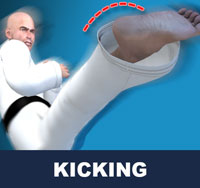

Kicking ( 차기 chagi ) is a physical strike using the foot ( 발 bal ), leg, or knee ( 무릎 mureup ). As the human leg is longer and stronger than the arm ( 팔 pal ), kicks ( 차기 chagi ) are generally used to keep an opponent at a distance, surprise him or her with their range, and inflict substantial damage. Any attempt to deliver a kick ( 차기 chagi ) will necessarily compromise one's stability of stance ( 서기 sogi ).
Question. What is the korean terminology for kicking?
Answer you gave was: ( 서기 sogi )
Your answer is wrong! You need to study more!
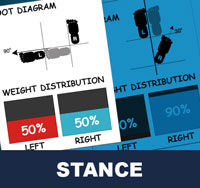

The Korean martial arts has several Stances ( 서기 sogi ) used for different activities. Although there are strong similarities in stances throughout taekwondo schools, individual instructors often have their own preferred style. These stances are most commonly seen in taekwondo forms, and are critical for balance, precision, and good technique in the martial art.
Question. What is the korean terminology for kicking?
Answer you gave was: ( 막기 makgi )
Your answer is wrong! You need to study more!
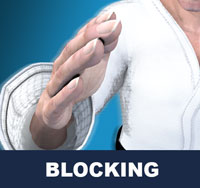

In martial arts, blocking ( 막기 makgi ) is the act of stopping or deflecting an opponent's attack for the purpose of preventing injurious contact with the body. A block ( 막기 makgi ) usually consists of placing a limb across the line of the attack. Blocks ( 막기 makgi ) are considered by some to be the most direct and least subtle of defensive techniques.
Question. What is the korean terminology for kicking?
Answer you gave was: ( 치기 chigi )
Your answer is wrong! You need to study more!
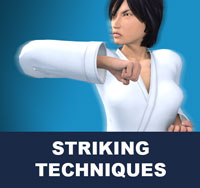

Taekwondo Strikes ( 치기 chigi ) are performed as a close distance alternative to kicks. Hand strikes make up fast combinations of strikes which can leave an opponent stunned and unable to defend himself. Striking ( 치기 chigi ) are taekwondo techniques striking with the twisting force of the body excluding techniques using the fist ( 주먹 jumeok ) or fingertips ( 손끝 sonkkeut ).


Taekwondo Kicks ( 차기 chagi )
A kick ( 차기 chagi ) is a physical strike using the foot, leg, or knee. As the human leg is longer and stronger than the arm, kicks are generally used to keep an opponent at a distance, surprise him or her with their range, and inflict substantial damage. On the other hand, stance ( 서기 sogi ) is very important in any combat system, and any attempt to deliver a kick will necessarily compromise one's stability of stance ( 서기 sogi ). For more information View Taekwondo Kicks ( 차기 chagi ) »
- History of Kicking
- Front Kick ( 앞차기 ap-chagi )
- Side Kick ( 옆차기 yeop-chagi )
- Roundhouse ( 돌려차기 dollyeo-chagi )
- Spin Kick ( 뒤후려차기 dwi-huryeo-chagi )
- Jump Kick ( 뛰어차기 ttwieo-chagi )
- Jumping Front Kick ( 뛰어 앞차기 ttwieo-ap-chagi )
- Jumping Side Kick ( 뛰어 옆차기 ttwieo-yeop-chagi )
- Jumping Back Thrust Kick ( 뛰어 뒤차기 ttwieo-dwi-chagi )
- Jumping Turn Kick ( 뛰어 돌려차기 ttwieo-dollyeo-chagi )
- Front Kick with Instep ( 발등 앞차기 baldeung-ap-chagi )
- Front Kick with Ball of the Foot ( 앞축 앞차기 apchuk-ap-chagi )
- Front Kick with Heel of Foot ( 뒤축 앞차기 dwichuk-ap-chagi )
- Front Foot Kick ( 앞발 차기 apbal-chagi )
- Front Foot Front Kick ( 앞발 앞차기 apbal-ap-chagi )
- Front Foot Side Kick ( 앞발 옆차기 apbal-yeop-chagi )
- Front Foot Axe Kick ( 앞발 내려차기 apbal-naeryeo-chagi )
- Front Foot Roundhouse ( 앞발 돌려차기 apbal-dollyeo-chagi )
- Front Foot Whip Kick ( 앞발 후려차기 apbal-huryeo-chagi )
- Turn Kick with Ball of Foot ( 앞축 돌려차기 apchuk-dollyeo-chagi )
- Target Kick ( 표적차기 pyojeok-chagi )
- Twisting Kick ( 비틀어차기 biteureo-chagi )
- Scissors Kick ( 가위차기 kawi-chagi )
- Repeating Kick ( 거듭차기 geodeup-chagi )
- Repeating Turn Kick ( 거듭 돌려차기 geodeup-dollyeo-chagi )
- Repeating Side Kick ( 거듭 옆차기 geodeup-yeop-chagi )
- Knee Upward Strike ( 무릎 올려치기 mureup-ollyeo-chigi )
- Jumping Flip Kick ( 공중제비차기 gongjungjebi-chagi )
- Jump Two-Foot Front Kick ( 뛰어 두발 앞차기 ttwieo-dubal-ap-chagi )
- Multi-Direction Kick ( 다방향차기 dabangyang-chagi )
- Single Line-up Break ( 일렬격파 illyeol-gyeokpa )
- Back Kick ( 뒤차기 dwi-chagi )
- Reverse Side Kick ( 반대 옆 차기 bandae-yeop-chagi )
- Hook Kick ( 후려차기 huryeo-chagi )
- Axe Kick ( 내려차기 naeryeo-chagi )
- Outward Crescent Kick ( 바깥차기 bakkat-chagi )
- Inward Crescent Kick ( 안차기 an-chagi )
- Whirl Kick ( 돌개차기 dolgae-chagi )
- 360º Whirl Kick ( 360º도 돌개차기 360º dolgae-chagi )
- 540º Whirl Kick ( 540º도 돌개차기 540º dolgae-chagi )
- 720º Whirl Kick ( 720º도 돌개차기 720º dolgae-chagi )
- 1080º Whirl Kick ( 1080도 돌개차기 1080º dolgae-chagi )
- Pushing Kick ( 밀어차기 mireo-chagi )
- Pushing Front Kick ( 밀어 앞차기 mireo-ap-chagi )
- Pushing Side Kick ( 밀어 옆차기 mireo-yeop-chagi )
- Counter Kick ( 받아차기 bada-chagi )
- Rear Foot Counter Kick ( 뒷발 받아차기 dwitbal-bada-chagi )
- Front Foot Counter Kick ( 앞발 받아차기 apbal-bada-chagi )
- Alternating Kick ( 이어차기 ieo-chagi )
- Holding Kick ( 잡고차기 japgo-chagi )
- Holding Whip Kick ( 잡고 후려차기 japgo-huryeo-chagi )
- Skipping Kick ( 발붙여차기 balbucheo-chagi )
- Skipping Front Kick ( 발붙여 앞차기 balbucheo-ap-chagi )
- Skipping Side Kick ( 발붙여 옆차기 balbucheo-yeop-chagi )
- Skipping Roundhouse Kick ( 발붙여 돌려차기 balbucheo-dollyeo-chagi )
- Skipping Axe Kick ( 발붙여 내려차기 balbucheo-naeryeo-chagi )
- Skipping Whip Kick ( 발붙여 후려차기 balbucheo-huryeo-chagi )
- Flying Kick ( 두발당성차기 dubaldangseong-chagi )
- Jumping Back Whip Kick ( 뛰어 뒤후려차기 ttwieo-dwi-huryeo-chagi )
- Jumping Axe Kick ( 뛰어 내려차기 ttwieo-naeryeo-chagi )
- Jumping Inward Crescent Kick ( 뛰어 안차기 ttwieo-an-chagi )
- Jumping Outward Crescent Kick ( 뛰어 바깥차기 ttwieo-bakkat-chagi )
Risk of injury can be reduced by completing an effective warm up consisting of a heart raiser to get your pulse up, followed by sport specific dynamic stretches (stretches whilst moving). Please follow the guidance of a certified Master Instructor or trainer when doing sports related activities. Depending on the intensity of the exercise, cooling down can involve a slow jog or walk, or with lower intensities, stretching can be used. Cooling down allows the heart rate to return to its resting rate. View more information on Warming Up and Cooling Down ».
This article uses material from the Wikipedia articles "Warming Up" and "Cooling Down", which is released under the Creative Commons Attribution-Share-Alike License 3.0.
RESOURCES
This article uses material from the Wikipedia article "540 Kick" which is released under the Creative Commons Attribution-Share-Alike License 3.0.








